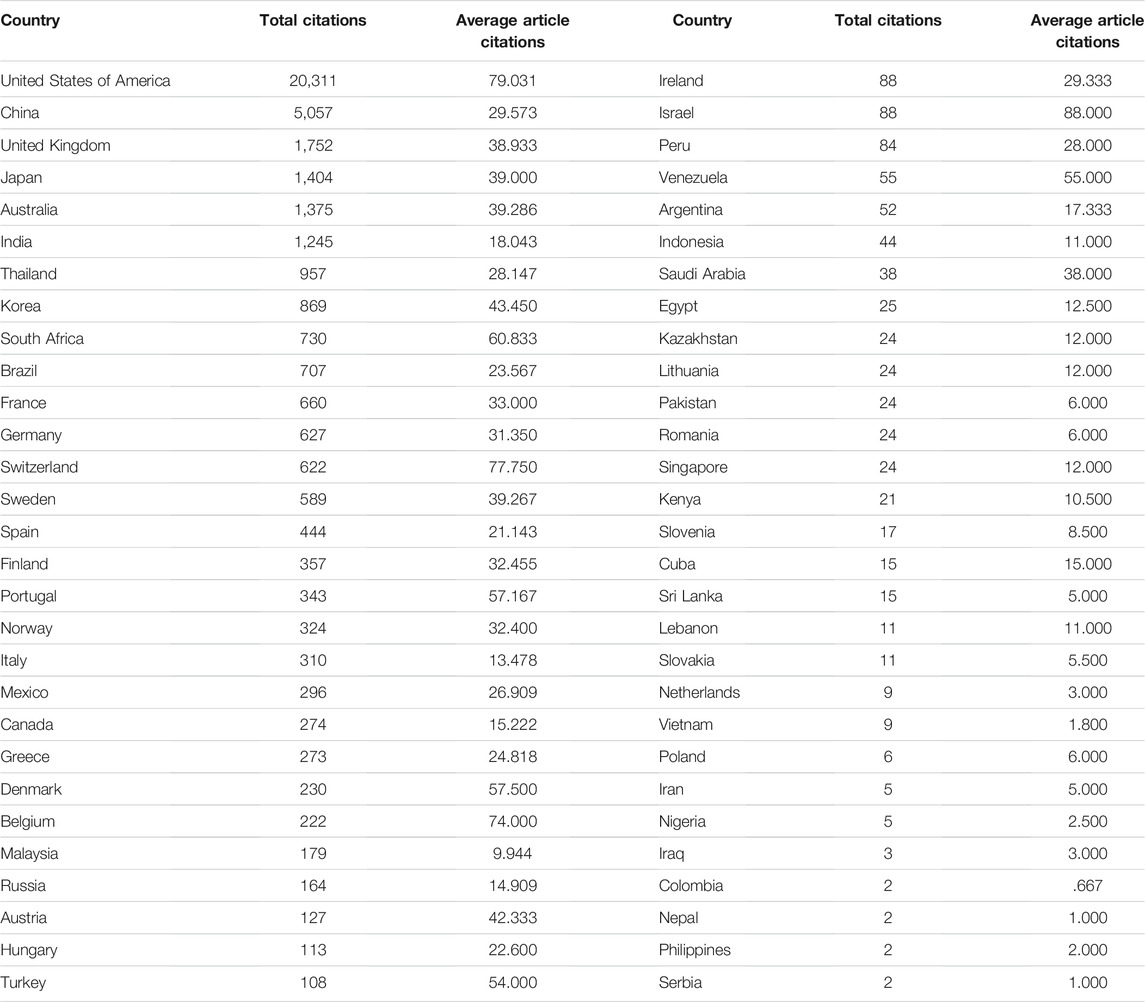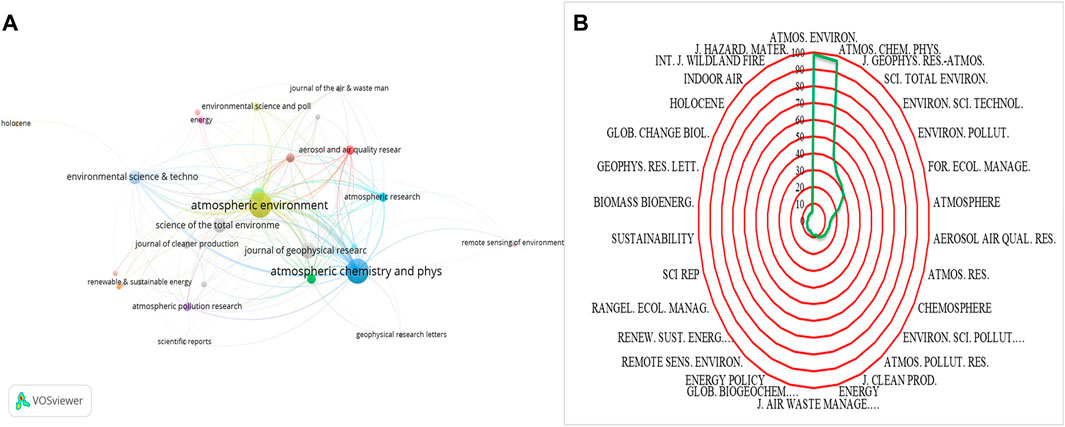- 1Key Laboratory of Meteorological Disaster, Ministry of Education (KLME), Joint International Research Laboratory of Climate and Environment Change (ILCEC), Collaborative Innovation Center on Forecast and Evaluation of Meteorological Disasters (CIC-FEMD), CMA Key Laboratory for Aerosol-Cloud-Precipitation, Nanjing University of Information Science and Technology, Nanjing, China
- 2School of Atmospheric Physics, Nanjing University of Information Science and Technology, Nanjing, China
- 3School of Environmental Science and Engineering, Nanjing University of Information Science and Technology, Nanjing, China
- 4Institute of Soil and Environmental Sciences, University of Agriculture, Faisalabad, Pakistan
- 5Department of Environmental Health, College of Public Health, Imam Abdulrahman Bin Faisal University, Dammam, Saudi Arabia
- 6Faculty of Sciences, Department of Mathematics and Statistics, University of Agriculture, Faisalabad, Pakistan
- 7Engineering and Technology Research Center for Agricultural Land Pollution Prevention and Control of Guangdong Higher Education Institutes, College of Resources and Environment, Zhongkai University of Agriculture and Engineering, Guangzhou, China
- 8Engineering and Technology Research Center for Agricultural Land Pollution and Integrated Prevention, Faisalabad, Pakistan
- 9CSIRO Land and Water, Glen Osmond, SA, Australia
- 10Future Industries Institute, The University of South Australia, Mawson Lakes, SA, Australia
- 11Department of Agronomy, University of Haripur, Pakhtunkhwa, Pakistan
- 12Prince Sultan Institute for Environmental, Water and Desert Research, King Saud University, Riyadh, Saudi Arabia
- 13Department of Soil Science, College of Food and Agricultural Sciences, King Saud University, King Saud, Saudi Arabia
Since open biomass burning (OBB) and open crop straw burning (OCSB) could pose a great risk to human health via altering the air quality, these practices have grabbed considerable attention from the scientific community and policymakers in recent years. In order to have a greater and deeper understanding of the contributions of both OBB and OCSB on air quality, a bibliometric analysis was performed using the Web of Science core collection to understand the research developments and future perspectives of these issues between 1991 and 2021. VOSviewer software 1.6.15 and R version 4.0.3 were employed to determine the annual scientific production trend and the role of countries, institutions, authors, and journal metrics network analysis. The findings showed that the interest in the study of OBB and OCSB pollution related to air quality has increased significantly over the last decade. A total of 1,021 publications were retrieved, with English as the most preferably used language. Among all documents, research articles were the most commonly appearing document type, and the researchers mainly emphasized environmental science, meteorology, atmospheric sciences, energy fuels, and environmental engineering fields. In terms of article analysis, Atmospheric Chemistry Physics, followed by Atmospheric Environment, was found to be the leading journal in this research domain, whereas the most frequently utilized keywords in the documents were biomass, biomass burning, and PM2.5. In terms of countries, the United States emerged as the leader with the highest publication rate, followed by China and India. The Chinese Academy of Sciences was ranked first in the list of most productive institutions, followed by the University of Montana and the US Forest Service. Based on the analysis, the finer spatial and temporal resolution and the characterization and understanding of the complex processes that are occurring in the atmosphere, such as clustering, oxidation, surface chemistry, and their impact on air quality, need to be explored in depth. Our research analysis can provide a baseline for future studies in air quality.
Introduction
Crop straw and/or crop residues are among the richest sources of biomass, and the quantity of burning of open crop straw is growing with the intensification of agricultural practices (Kholif et al., 2017). It ultimately causes climate change and exacerbates crop productivity (Elahi et al., 2021a). Fire plays a key role in ecosystem services, such as maiden zones for livestock, pest control, and weed eradication (Shimabukuro et al., 2013). Presently, around half of the world’s inhabitants use open crop straws for cooking and household heating, in addition to burning for removal from fields specifically in the countryside of the developing world (Nayek and Padhy, 2017; Sun et al., 2017). Unfortunately, fire utilized to remove crop straws from agricultural fields mainly in Southeast Asia produces heavy smoke (termed as haze pollution) that can spread to nearby regions or even countries, triggering transboundary pollution and attracting special attention to the atmospheric pollution episodes (Duan et al., 2004; Mehmood et al., 2020).
Open biomass burning (OBB) is a global phenomenon in which the practice of burning of forests, grassland, and residues from crops results in the heavy atmospheric emissions of particulate matter (PM), especially fine particles (PM2.5) and carbonaceous aerosols, including organic carbon (OC), elemental carbon (EC), and other gaseous pollutants (Van Der Werf et al., 2010; Wenlian et al., 2014; Qiu et al., 2016; Zhou et al., 2018; Mehmood et al., 2020). Globally, OBB contributes to around 40 and 65% of the annual average of EC and OC, respectively, and >45% of PM2.5 concentrations (Deng et al., 2011; Bond et al., 2013). Each year, more than 25% of PM2.5 emissions in the US originate from OBB (Kolden, 2019), while in China, it is around 15–24% (Song et al., 2007; Cheng et al., 2013), whereas in Southeast Asia and South China it is below 70% (Fu et al., 2012). The high emission of these pollutants poses a considerable risk on air quality, human health, and climate change at the regional and global levels (Andreae and Merlet, 2001; Bond et al., 2004; Akagi et al., 2011; Zhang L. et al., 2016; Mehmood et al., 2018)—for example, high PM2.5 concentrations (200 μg/m3) with <90% of relative humidity for more than 4 h (Du et al., 2011) lead to a reduction in visibility below 10 km (Chen et al., 2017).
Globally, farmers utilize fire as a tool for the clearance of open crop straw from their fields (McCarty et al., 2009). Compared with other methods, open crop straw burning (OCSB) is the most effective and least expensive tool to clear crop straw in the field, thus attracting farmers to follow this practice to get rid of crop residues. In their seminal publication, Andreae and Merlet (2001) noted that OCSB was considered as the fourth major kind of OBB after charcoal making, charcoal burning, and biofuel burning. On a global basis, agricultural burning in China contributed to 3–6% of the global agricultural fires during the year 2000 (Charlesworth et al., 2003), while during 2000–2007, OCSB contributed to about 2/3 of the total biomass burning (Tian et al., 2011).
Recent estimates show that the pace of OCSB seems to have accelerated due to agricultural interventions, such as clearing of crop straw, managing pests, and providing short-lived ash fertilization (Cheng et al., 2014; Mehmood et al., 2020). Significant OBB, especially from OCSB, occurs during May to June and October to November due to harvesting of crops like rice, wheat, and maize and the subsequent burning of crop residues. It contributes to regional haze pollution and worsens the air quality in different parts of the world (Yu et al., 2014; Zhang K. et al., 2016; Qiu et al., 2016; Sipra et al., 2017), also harming the atmospheric environment both locally and at large distances downwind (Li et al., 2014; Zhang K. et al., 2016).
Generally, atmospheric pollution caused by OCSB is studied through the measurement of pollutants, the estimation of particulate species, and a numerical model simulation. Mittal et al. (2009) analyzed the variations in the concentration of aerosols, NO2, and SO2 in the troposphere before and after the OCSB. Several researchers have employed levoglucosan (Titos et al., 2017), K+ (Wu et al., 2016), and water-soluble organic carbon (Zong et al., 2015) as tracers to demonstrate the impact of straw burning on the downwind areas. These studies confirmed that the OCSB has a direct impact on air quality as well as the atmospheric composition by interacting with urban air pollutants which eventually convert into secondary pollutants (Grell et al., 2011; Singh et al., 2012). OCSB could also play a critical role in the deterioration of soil quality in terms of elevated pH after burning of crop straws with large deposition of black carbon (BC) and polyaromatic hydrocarbons (PAH) (Barreiro et al., 2016). Bikkina et al. (2019) suggested that large-scale open burning of post-harvest crop straw burning in surrounding rural regions is contributing to the severe haze pollution in Delhi especially during the winter and autumn seasons. Similarly, Nair et al. (2020) conducted a study to estimate the contribution of agriculture residue in air quality deterioration using multidisciplinary approaches over the region in Haryana, Punjab. Moreover, Irfan et al. (2015) developed a comprehensive emission inventory for pollutants released from crop straw burning, which covers pollutant emissions and their sources in Pakistan. Furthermore, at a large scale, OCSB contributed not only to reducing the visibility but also to the temporary closure of highways and airports (Li et al., 2014; Hua et al., 2015).
To date, a lot of research on OBB and OCSB has been conducted, which mainly emphasized emission inventory, emission characteristics, and the effects of burning on human health and the ecological environment. Bibliometric analysis is a well-established approach of library and information science, which is applied to evaluate and predict the new trends and development in the respective field (Bramness et al., 2013). Bibliometric research offers an imperative tool to estimate and measure the development of literature for a specific area of interest. Bibliometric analysis has been utilized in different perspectives to examine the data that illustrate the increase in publication frequency, identification of key authors, research funding agencies, research institutions, and countries (Xu et al., 2013). Although few studies on the bibliometric analysis of OBB have been investigated, there is a lack of inclusive and systematic analysis of research progress and future trends. Besides this, the relationship between OBB, OCSB, and air quality is rarely explored. Therefore, it is important to analyze OBB and OCSB concerning air quality and parallel to the development of necessary mitigation measures.
Based on the model of bibliometric analysis, this study aims at examining the frame of information in the field of OBB, OCSB, and air quality research during 1991–2021 through bibliometric analysis, social network analysis (SNA), Sankey three-field plot, and citation networks. Specifically, publications, authors, keywords, research funding agencies, research institutions, and countries were studied. The SNA and citation networks are very innovative in the exploration of this research domain. In the current study, a bibliometric analysis was conducted to (1) examine the research landscape of OBB and OCSB on air quality in terms of journals, author’s domains, keywords, and cited work; (2) recognize the collaboration among research institutions; and (3) explore the burning issues and the future scenario.
Data Sources and Methods
The data for bibliometric analysis were retrieved from the Web of Science Core Collection (WoSCC) on May 11, 2021. The data also included the articles that were accepted for publication in 2021 and which were available online. The Web of Science (WoS) was selected due to its robust analysis and comprehensive information for bibliometric study as compared to other databases (Aghaei Chadegani et al., 2013; Yi et al., 2016). According to Journal Citation Reports from 2019, WoSCC was composed of 21,100 peer-reviewed high-quality scientific journals with more than 250 sciences. It covers Science Citation Index (SCI)—Expanded, Social Science Citation Index (SSCI), Arts and Humanities Citation Index (A&HCI), Conference Proceedings Citation Index (CCPI), Emerging Source Citation Index (ESCI), Current Chemical Reactions (CCR—Expanded), and Index Chemicus (IC). The search strategy employed for this work is illustrated in Supplementary Figure S1. The selection of keywords method was refined until the desired citation was completed. Afterward, the retrieved documents were screened based on our study scope and to ensure the purpose of this research, such that these completely cover the topic related to the contributions of OBB and OCSB to air quality. This study used the equation TS = [(open biomass burning) OR (open crop straw burning) AND (haze)] to retrieve the documents from WoS database. The period was selected from 1991 to 2021. The documents included research articles, review articles, reviews, early access articles, book chapters, editorials, abstracts, letters, proceedings papers, and reprints.
This study covers a total of 1,021 publications in 9 document types that were retrieved from the WoSCC database during 1991–2021. This study focused exclusively on the documents published in the English language. Of all document types, research articles (865) accounted for 84.72%, followed by proceeding papers (65, 6.36%), review articles (52, 5.09%), editorials (4, .39%), abstracts (3, .29%), letters (2, .19%), and others (2.54%) The most published document type was research articles, which is in line with other bibliometric analysis using the SCI—Expanded database (Zhang K. et al., 2016; Dhital and Rupakheti, 2019).
The study of the global scientific literature on OBB and its effects on air quality was performed through a bibliometric network analysis, which syndicates both bibliometric and SNA to explore the specific area of science (Zou et al., 2018; Dhital and Rupakheti, 2019). The SNA is the method of studying social configurations through the application of a graph and network theory using data visualization software (Otte and Rousseau, 2002). The SNA and map-based analysis are helpful to identify pattern recognition in bibliometric science, allowing the construction of network maps as well as establishing statistical relationships among countries, journals, organizations, authors, and keywords pertaining to the research topic (Chen et al., 2016). In this study, we used h-index, g-index, and m-index metrics. The h-index is an author-level metric which measures both the productivity and citation impact of the researcher. The g-index is computed as the given set of articles ranked in decreasing order of the number of citations that they received. The m-index is another variant of the h-index that presents the h-index per year since its first publication.
This study employed VOSviewer software (version 1.6.15) and R version 4.0.3. for mapping, tabulation, and visualization (van Eck and Waltman, 2010). The visualization method could be illustrated as a network, overlay map, and density from 1991 to 2021. The network visualization utilizes different colors to represent different clusters, such as institutions, countries, and authors, and the linking lines indicate parameters, such as co-citation and collaboration. The size of the circle illustrates the magnitude of each parameter. The strength of co-citation is estimated by the thickness of linking lines and is mathematically denoted as relative link strength. Supplementary Table S1 summarizes the main technical terms used by the VOSviewer software and Sankey three-field plot. The analysis included co-authorship, co-occurrence, and citation used in this study (Van Eck and Waltman, 2019). In co-authorship webs, countries, researchers, and research institutions are connected, considering the number of document types such as research articles, proceeding papers, and review papers which they have authored jointly. The co-occurrence analysis includes the number of two keywords in the publications in which both keywords occur jointly in the keyword list, abstract or title, and citation analysis, if at least one cites the other.
Results and Discussion
Annual Scientific Production Trend During 1991–2021
The life of scientific literature is linked to the number of citations. Both publication and citation trends can be helpful to illustrate the connections between citation per publication and the article lifespan (Chiu and Ho, 2007; Chuang et al., 2007). Supplementary Figure S2 shows the average citation per year (a) and annual scientific production (b) during 1991–2021.
Lower citation scores were recorded during 1991–2005, primarily due to the lower number of documents published and, secondly, less frequent OBB events that occurred during this period. As evident from Supplementary Figure S2A, the number of citations increased from 2013 to 2019, suggesting that the topic gained significant attention presumably due to the increased OBB and OCSB events and their effect on air quality globally.
To better understand the publications and trends during the selected period, a linear regression model was applied. Figure 1 displays the trend of annual publications and cumulative number related to OBB and OCSB on air quality research from 1991 to 2021. The average number of publications was ∼33 documents per year. A growing trend in the number of publications was noticed over the years which is estimated by the linear growth curve, resulting in the following equation:
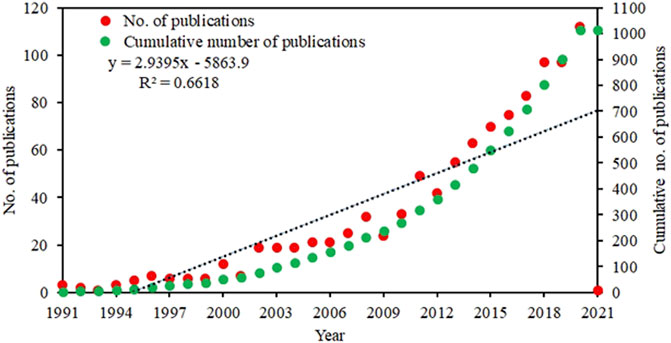
FIGURE 1. Publication trend on open biomass burning (OBB) and open crop straw burning (OBB) on air quality research.
The highest productivity was observed in 2020 with 112 publications (10.96% of the total), although the minimum number of publications was recorded in 1993 and 2021 with only one publication (0.19% of the total) during 1991–2021. The increasing trend of the number of publications since 2010 highlights the fact that the research on the role of OBB and OCSB on air quality has gained worldwide attention. From 1991 to 2001, the frequency of the publication was low (5.6%), which gradually increased to 41.33% during 2002–2014. However, in the last 5 years (2015–2020), a drastic growth in the frequency of publications was observed, with 52.30% of the total publications appearing during this period. The increasing number of publications in the last decade is primarily due to a large number of biomass burning events reported around the world, fueled by increasing awareness of global climate change among the community. Furthermore, it is also observed in the reports that the number of fire events was higher compared with the average over the 2000–2017 period (San-Miguel-Ayanz et al., 2018; Adam et al., 2020), while the burnt area was also increased. This implies that with the increase in biomass burning that occurred, research on this topic has also gained attention from policymakers and researchers.
Scientific Contribution of Countries
The contribution of different countries on this topic was determined by the affiliation of a minimum of one author listed in the publications. The 1,021 documents retrieved in the WoSCC included authors from 83 countries. Table 1 shows the countries with total citations (TC) and average article citations (AAC), with the United States (20,311 citations; average citations of 79.03) ranked as the highest, followed by China (5,057 citations; average citations of 29) and the United Kingdom (1,752.38 citations; average citations of 38). Figures 2A,B presents all countries with publications and SNA related to OBB and OCSB on air quality research based on single-country publications (SCP) and multi-country publications (MCP). Supplementary Table S2 presents a global analysis based on SCP, MCP, frequency, and MCP ratio. Researchers from Asian countries, such as China, India, Japan, and Thailand, and European countries, including Italy and Spain, have actively published papers on these topics. The United States contributed the maximum number of publications, with a total of 257 (25.17% of the total) documents, followed by China with 172 (16.84 of the total) and India with 72 (7.05% of the total), respectively. The number of publications, to some extent, represents the academic impact and research output of these countries. The United States had 46 links, with a total link strength of 3,465 with one cluster, and the strongest link was developed by China, with 46 links and a total link strength of 288 with four clusters (Figure 2A). Overall, both the United States and China were found to be the top two countries where OBB and OCSB research was extensively conducted.
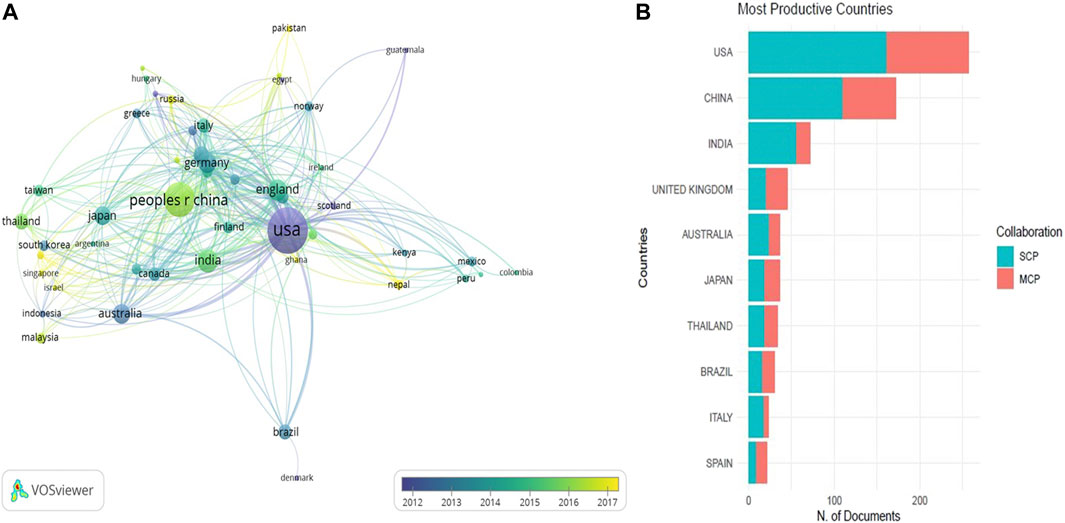
FIGURE 2. Social network analysis (SNA) of countries (A) and world top 10 countries with publications (B) related to OBB and OCSB on air quality research.
An analysis of top institutions revealed that China and the United States were the most significant contributors to the research on air quality due to OBB and OCSB (Figure 2B), whereas the United Kingdom, Japan, Australia, India, Thailand, Korea, South Africa, and Brazil were in the list of the top 10 countries with the most productive institutions. The higher productivity of research in China and the United States are attributed to funding availability in these countries. On the other hand, the level of inter-institutional collaboration was found to be poorer than international collaboration. It is mainly due to the regionalized distribution of institutions in these countries and the lack of comprehensive research on the research topic at each institution. The data also indicate that the United States and China have put in significant research efforts to explore the possible effects of OBB and OCSB on air quality.
Author Keyword Network and Research Hotspots
The analysis of words used in titles, abstracts, and author keywords can be useful when estimating the research areas because they cover the important information that authors want to present to their readership (Wang and Ho, 2016). The keywords were selected for analysis in this research, which can reasonably explore the depth of publication to reflect the focal areas of research and develop the direction, particularly the high-frequency keywords (Hamidi and Ramavandi, 2020).
Conversely, keywords plus could not completely cover the core content of the document by Thomson Reuters. Because some keywords with the same meaning have several variations, it is essential to homogenize these keywords before analysis—for instance, biomass burning and open burning were both aggregated to open biomass burning.
Table 2 shows the author keywords and author keyword plus networks related to OBB and OCSB air quality research. The results indicated that the most recurrently encountered author keywords and author keyword plus were “biomass burning” (110), “biomass” (47), and “PM2.5” (39) and “biomass” (163), “particulate matter” (110), and “emissions” (107), respectively. A keyword co-occurrence analysis was performed through VOSviewer 1.6.15 software by retrieving raw files from the WoSCC database, and a visual map was developed for better illustration of the author keywords. The keyword “biomass burning” created 41 links, with a total link strength of 121 and with 2 clusters, followed by “PM2.5” with 27 links of a total of 59 link strength along with 2 clusters (Figure 3A). Figure 3B shows a Pareto chart that contains both bars (representing the values of keyword reoccurrence) and a line graph (showing the descending order of frequency with a cumulative line on the secondary axis as a percentage of the total). Supplementary Figure S3 shows the words cloud plot (a) and words cloud network data (b). Overall, there was a total of 66 items with 7 clusters and 360 links and 579 total link strengths. Moreover, the recurrent occurrence of keywords such as “biomass burning,” “biomass,” “fire” “PM2.5” “black carbon”, and “air pollution” indicates that air quality caused by OBB and OCSB has drawn significant attention. Several studies employed keywords including “PM2.5,” “PAH,” “particulate matter,” and “PM10” from OCSB during cooking or heating in rural areas, which have a considerable impact on indoor air quality due to low combustion efficiency. Consequently, it has several adverse effects on the human lungs (Sarigiannis et al., 2015).
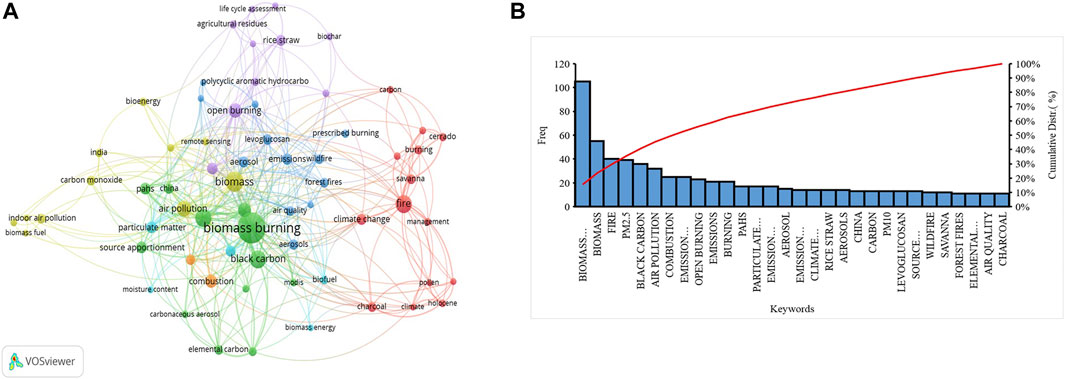
FIGURE 3. The SNA for author keywords (A) with Pareto chart that contains both bars (represents the values of keyword re-occurrence) and a line graph (showing the descending order of frequency with a cumulative line on the secondary axis as a percentage of the total) (B).
Active Journal Distribution Analysis
The distribution of active journals is the primary part of a bibliometric analysis (Chiu and Ho, 2007). A total of 28 journals have published 1,021 research articles related to OBB and OCSB and their effects on air quality from 1991 to 2021. Figures 4A,B shows the SNA for active journals (4.a) and the radar analysis for journal frequency (4b). Table 3 presents the world journals with h-index, g-index, TC, number of publications, publication year start. Atmospheric Environment was the most productive journal (100 articles, 9.5%), followed by Atmospheric Chemistry Physics (97 articles, 9.50%) and Journal of Geophysical Research (42 articles, 4.11%). However, Atmospheric Chemistry Physics scored the highest for h-index (39), g-index (72), and m-index (3.5454). Figure 5A shows the relationship among the top keywords, top authors, and top journals summarized by a Sankey plot.
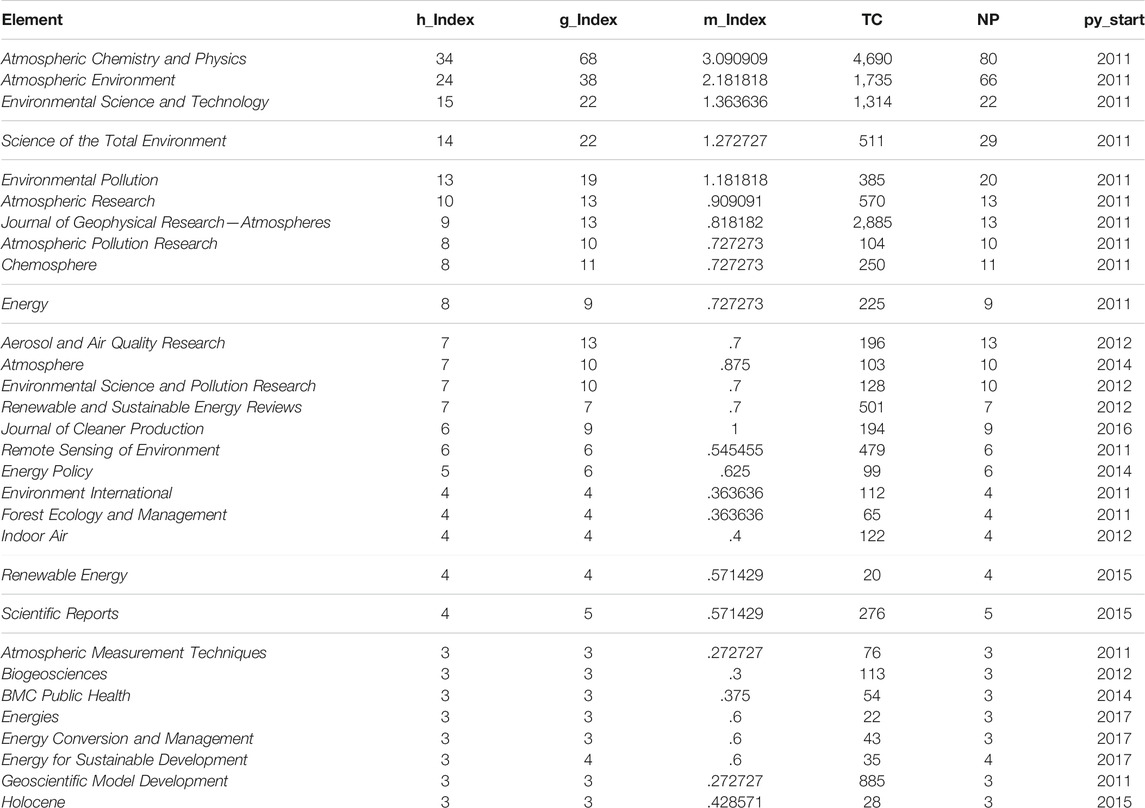
TABLE 3. World journals with h-index, g-index, total citation (TC), number of publications (NP), and publication year start (py_start).
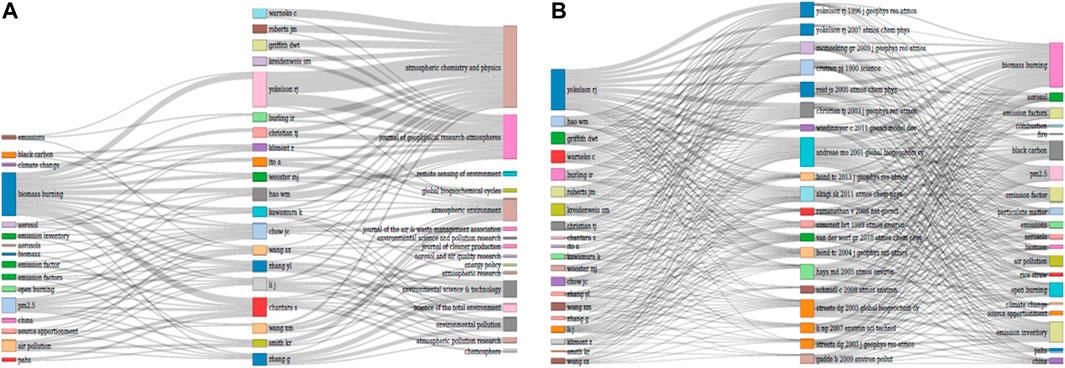
FIGURE 5. Relationship among top keywords, top authors and top journals summarized by a Sankey Plot (A) and relationship among top authors, references they cite and keywords they use summarized by a Sankey Plot (B).
The top 10 active journals that addressed the topic of this research covered the fields of environmental sciences, meteorology, atmospheric sciences, energy fuels, and environmental engineering. The most influential journal in these fields is Atmospheric Chemistry Physics, with an impact factor of 5.414 in 2019. This journal grabbed 6,050 citations with three clusters and 19 links and is dedicated to studies on the earth’s atmospheric and essential physical and chemical processes. The main core areas comprise field measurements and atmospheric modeling, clouds and precipitations, radiations, laboratory studies, remote sensing, and aerosols, whereas Atmospheric Environment was the second most influential journal, with an impact factor of 4.039 in 2019, capturing 4,568 citations with 4 clusters and 23 links. The major subject areas for Atmospheric Environment are atmospheric composition and its impacts on the ecosystem. In addition, this journal also covers atmospheric emissions and the deposition of gases and particulate compounds along with the impacts on air quality and human health. Both Atmospheric Chemistry Physics and Atmospheric Environment developed a total strength of 565 and 524, respectively.
Active Journal Distribution Analysis
The institutional contribution analysis was carried out based on the author’s affiliation address. A total of 1,415 institutions contributed to 1,021 articles during 1991–2021. The most productive institutions in the field of OBB and OCSB are illustrated in Figure 6. Co-authorship with organization analysis indicated that the top four institutions have accounted for 16.76% of the total 1,021 publications. It was also revealed that the Chinese Academy of Sciences (CAS), with 68 documents with 2,376 total citations and a total strength of 104, was the most productive institution. The CAS encompasses 100 sub-institutes nationwide, and all the data of these sub-institutes were aggregated into CAS research. This is one of the reasons that CAS ranked first in OBB and OCSB pollution research. The second most influential institution was the University of Montana (UoM) with 34 documents. The UoM received 3,697 citations, which was higher than the CAS, and had a total link strength of 92. The US Forest Services (USFS) received 2,402 citations with 33 documents and a total strength of 60. Citations and organization analysis indicated that the UoM was a highly productive institution with 34 documents and a total link strength of 2,044, followed by the USFS with 33 documents and a total link strength of 1,380. This study also shows that the top four institutions belonged to the United States except for the CAS. These institutions have several links with other organizations (Figure 6).
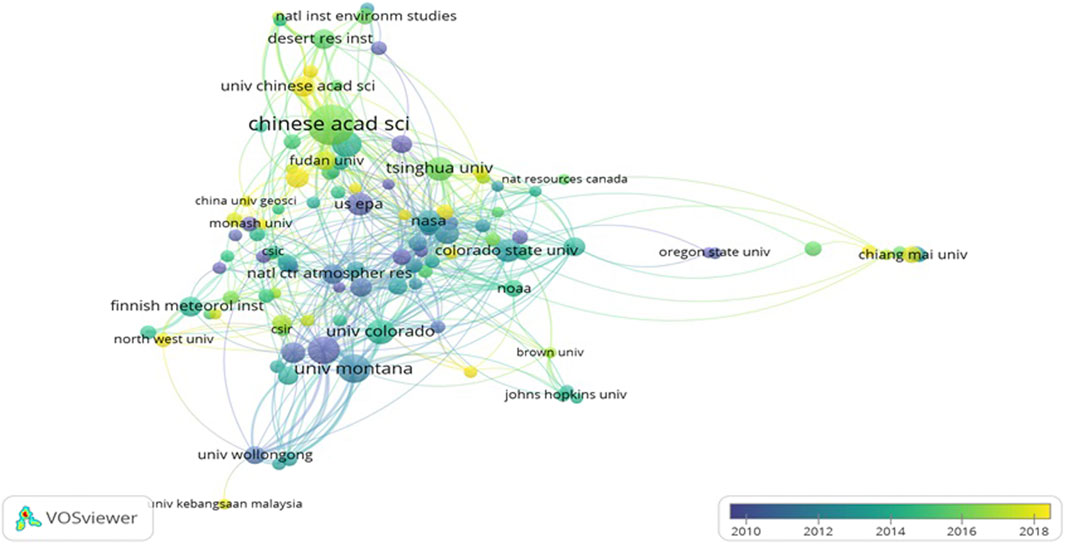
FIGURE 6. Overlay visualization of world’s most productive institutions in the field of OBB and OCSB.
The publications from the United States institutions, however, showed a relatively low collaboration in terms of international research exchange with other institutions, especially in Asia. It is evident that the maximum number of publications was contributed by the United States and China, and only a few publications demonstrated international collaboration. In China and the United States, the most dominant institutions which are conducting research on OBB and OCSB are the CAS and the UoM, highlighting that the most productive institution in each country may help researchers explore potential avenues appropriate for their research exchange activities, workshops, training, and post-doctoral study tours (Vanzetto and Thomé, 2019).
Authorship Analysis and Citations Network
The citation network analysis explains the citation scores of the author and is helpful to understand the importance of the research work on a specific topic. We used local citation scores (LCS) and global citation scores (GCS) for articles during 1991–2021. Akagi et al. (2011) received a GCS of 792 and an LCS of 103, followed by Streets et al. (2003) who received a GCS of 487 and an LCS of 81. Maximum citation (2,495) was observed for Bond et al. (2013) (Supplementary Table S3). Figure 5B shows the relationship among top authors, references that they cite, and keywords that they use summarized by a Sankey plot.
The total number of authors who contributed to the published documents was 110, with an average of 9.0 authors per document. The maximum number of documents were published by RJ Yokelson, followed by WM Hao and J Li. The top active authors were primarily from the United States, Germany, and China. Authors with a minimum productivity of five publications were also observed by utilizing the network visualization map, which presented research networking among active authors (Supplementary Figures S4A,B). This indicated that RJ Yokelson was the most active author with a maximum productivity of 14 publications in two clusters with seven links and 31 link strengths. Similarly, the maximum frequency (35) was observed for RJ Yokelson, followed by J Li and K Kawamura (Supplementary Figure S4A). Supplementary Table S4 shows the author analysis with dominance factor (DF) and rank DF based on single author, first author, and multi-authors. Ito A authors have gained the maximum DF (0.875) among all authors. Supplementary Table S5 presents the year-wise analysis based on citations, mean total citation per article, and citable years. Highly cited articles with citable years were noted in 2004–2011. This indicates that these years were the most productive years in terms of citation analysis.
Highly Impactful Articles Related to OBB and OCSB
The number of citation analysis signifies its utmost key bibliometric features because it shows the importance and reputation of a study in the scientific community. The highly impactful article (HIA) is a measure of a high-quality publication. Wang and Ho (2016) suggested that researchers should emphasize on recent highly impactful papers by considering their citations in the most recent year. Table 4 shows the list of the world’s top 10 highly cited and impactful articles during 2011–2021. The most highly impactful article was published by Bond et al. (2013) in Journal of Geophysical Research-Atmospheres, with 2,602 total citations and grabbing 289.11 average citations per year.
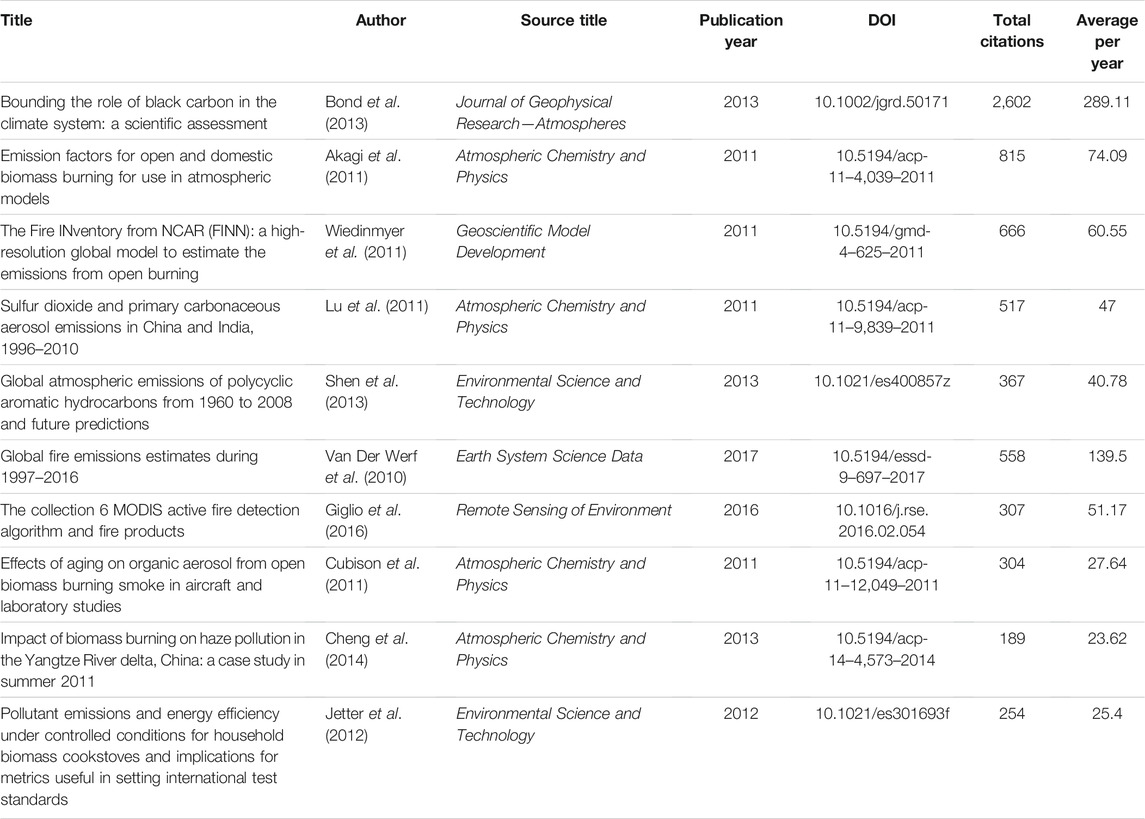
TABLE 4. Highly impactful articles related to open biomass burning and open crop straw burning during 2011–2020.
This article described the term BC and explained the framework which is used for quantifying climate forcing. Therefore, this paper has attracted significant attention from the scientific community. The HIA published by Akagi et al. (2011) in Atmospheric Chemistry Physics grabbed 815 total citations with 74.09 average citation per year. This study presents that individual OBB emits significantly more gas-phase non-methane organic compounds, which affect secondary organic aerosol and ozone formation. This study helped to improve the photochemical model performance. Overall, most of the studies emphasized the concerning OBB and OCSB emissions and the impacts on air quality, climate, and health over the globe, including the relationship to atmospheric dynamics and chemical processes. More specifically, OCSB is present in bulk form, and its plumes transport according to the weather condition. Therefore, it is highly recommended that OCSB campaigns should be planned during the harvest seasons. This will help to quantify the aging and complex chemical process and optical properties of OBB.
Current Steps and Future Perspectives
The review of literature, the analysis of results combined with abstracts, titles, author, and keywords, and the content of the documents suggest that further research is necessary to characterize OBB and OCSB emissions and their negative impact on the atmospheric environment and public health (Bikkina et al., 2019; Nair et al., 2020). Research trends in both OBB and OCSB pollutions indicate further studies focusing on the following:
• quantification of OCSB emission and identification of spatial and temporal pattern at a finer-resolution level and
• characterization and understanding of the complex processes occurring in the atmosphere, e.g., clustering, oxidation, and surface chemistry, and their impact on air quality
In the light of the above-mentioned points, an in-depth analysis of OBB and OCSB activities and their effects on air quality, especially on haze formation, is likely to play a key role in exploring new horizons and future research directions. However, as recent evidence has suggested that OCSB may have significant effects on air quality in China and other parts of the world, more relevant efforts should focus on the following key issues:
• large-scale real-time monitoring data and surveys updating the comprehensive OCSB, emission factors, and emission inventories especially across Asian countries to anticipate higher accuracy for OCSB atmospheric modeling,
• spatial–temporal comparison (like the diurnal patterns of pollutant concentrations in different seasons over the whole country) regarding OCSB emissions,
• evaluation of uncertainty in haze prediction events while taking into consideration the atmospheric, modeling, satellite, and laboratory studies, and
• detailed cross-sectional and longitudinal studies to elucidate the short-term and long-lasting air quality issues before it becomes a widespread issue. Moreover, studies are required to understand the socio-psychological behavior of people regarding adoption measures (Elahi et al., 2021b) to reduce environmental emissions.
Implications of This Work
The findings of this work are attributed to several major implications for the analysis of scientific productivity on the contributions of OBB and OCSB to air quality. These analyses highlighted a series of key information and data which enables researchers and policy makers to gain understanding on the role of countries, authors, institutions, and specific research hotpots on the theme of air quality in response to burnings. This study clearly illustrated the contribution of each country’s research productivity, research institutions, and renowned scientist related to famous institutions at the global level. The cutting edge research and research hotspot collected from the literature offer detailed information on the current and future perspectives on this theme. We have conducted an extensive analysis which provides the in-depth information for each parameter being used in this study—for instance, in terms of country, scientific country productivity implies the research status of a particular country in the future. Similarly, highly impactful articles indicated the significance of the research for a specific topic of interest. These can be referred to other bibliometric parameters, such as collaborations, number of citations, etc. The demarcation of tentative changes in research domain and trend compared to existing literature is an auxiliary key implication of this analysis, so this type of study may be beneficial for environmentalists and policy makers to gain in-depth understanding of current and future research.
Conclusion
Based on the 1,021 documents associated with OBB and OCSB research retrieved from the WoS database during 1991–2021, the current study executed a scientific study using a bibliometric approach, in which a literature review through academic documents published in English was conducted. The appropriate document types were analyzed quantitatively and qualitatively to investigate the connections between authors, countries, citations, keywords, and institutions. The results showed that the frequency of articles significantly increased in the last decade. The United States contributed the maximum number of publications, with a total of 257 (25.17% of the total) documents, followed by China with a total of 172 (16.84 of the total) and India with a total of 72 (7.05% of the total) documents, respectively. The most recurrently encountered author keywords were biomass burning, PM2.5, biomass, black carbon, air pollution, open burning, and fire. Atmospheric Chemistry Physics with h-index (39), g-index (72), and m-index (3.5454) was the most cited journal. Co-authorship with organization analysis indicated that the top four institutions included the Chinese Academy of Sciences, the University of Montana, the US Forest Services, and the Colorado State University, which, together, accounted for 16.76% of the total 1,021 publications. Previously, the research focused on the construction of an emission inventory of OBB and OCSB and examination of the effects of OBB and OCSB on atmospheric environment and public health. However, the most important topics, such as emission species, high-resolution inventories, and climate change, gained attention around the globe in more recent times.
Data Availability Statement
The original contributions presented in the study are included in the article/Supplementary Material, further inquiries can be directed to the corresponding authors.
Author Contributions
KM and YB contributed to conceptualization. KM contributed to methodology and writing—original draft preparation. KM and MY contributed to software. SD, Saifullah, and SB contributed to validation. Saifullah, MA, and SB contributed to formal analysis. MA and SF contributed to investigation. YB contributed to resources. SB contributed to data curation. KM, Saifullah, SB, SD, MY, TF, and MA contributed to writing—review and editing. MY and PS contributed to visualization. YB contributed to supervision. KM and YB contributed to project administration. All authors have read and agreed to the published version of the manuscript.
Funding
This study was supported by the National Natural Science Foundation of China (41975046).
Conflict of Interest
The authors declare that the research was conducted in the absence of any commercial or financial relationships that could be construed as a potential conflict of interest.
Publisher’s Note
All claims expressed in this article are solely those of the authors and do not necessarily represent those of their affiliated organizations or those of the publisher, the editors, and the reviewers. Any product that may be evaluated in this article or claim that may be made by its manufacturer is not guaranteed or endorsed by the publisher.
Acknowledgments
All authors would like to thank Nanjing University of Information Science and Technology for its computational resources.
Supplementary Material
The Supplementary Material for this article can be found online at: https://www.frontiersin.org/articles/10.3389/fenvs.2022.852492/full#supplementary-material
References
Adam, M., Nicolae, D., Stachlewska, I. S., Papayannis, A., and Balis, D. (2020). Biomass Burning Events Measured by Lidars in EARLINET - Part 1: Data Analysis Methodology. Atmos. Chem. Phys. 20, 13905–13927. doi:10.5194/acp-20-13905-2020
Akagi, S. K., Yokelson, R. J., Wiedinmyer, C., Alvarado, M. J., Reid, J. S., Karl, T., et al. (2011). Emission Factors for Open and Domestic Biomass Burning for Use in Atmospheric Models. Atmos. Chem. Phys. 11, 4039–4072. doi:10.5194/acp-11-4039-2011
Andreae, M. O., and Merlet, P. (2001). Emission of Trace Gases and Aerosols from Biomass Burning. Glob. Biogeochem. Cycles 15, 955–966. doi:10.1029/2000GB001382
Barreiro, A., Bååth, E., and Díaz-Raviña, M. (2016). Bacterial and Fungal Growth in Burnt Acid Soils Amended with Different High C/N Mulch Materials. Soil Biol. Biochem. 97, 102–111. doi:10.1016/j.soilbio.2016.03.009
Bikkina, S., Andersson, A., Kirillova, E. N., Holmstrand, H., Tiwari, S., Srivastava, A. K., et al. (2019). Air Quality in Megacity Delhi Affected by Countryside Biomass Burning. Nat. Sustain. 2, 200–205. doi:10.1038/s41893-019-0219-0
Bond, T. C., Doherty, S. J., Fahey, D. W., Forster, P. M., Berntsen, T., Deangelo, B. J., et al. (2013). Bounding the Role of Black Carbon in the Climate System: A Scientific Assessment. J. Geophys. Res. Atmos. 118, 5380–5552. doi:10.1002/jgrd.50171
Bond, T. C., Streets, D. G., Yarber, K. F., Nelson, S. M., Woo, J. H., and Klimont, Z. (2004). A Technology-Based Global Inventory of Black and Organic Carbon Emissions from Combustion. J. Geophys. Res. 109. doi:10.1029/2003JD003697
Bramness, J. G., Henriksen, B., Person, O., and Mann, K. (2013). A Bibliometric Analysis of European versus USA Research in the Field of Addiction. Research on Alcohol, Narcotics, Prescription Drug Abuse, Tobacco and Steroids 2001-2011. Eur. Addict. Res. 20, 16–22. doi:10.1159/000348260
Chadegani, A. A., Salehi, H., Yunus, M. M., Farhadi, H., Fooladi, M., Farhadi, M., et al. (2013). A Comparison between Two Main Academic Literature Collections: Web of Science and Scopus Databases. Ass 9. doi:10.5539/ass.v9n5p18
Charlesworth, S., Everett, M., McCarthy, R., Ordóñez, A., and de Miguel, E. (2003). A Comparative Study of Heavy Metal Concentration and Distribution in Deposited Street Dusts in a Large and a Small Urban Area: Birmingham and Coventry, West Midlands, UK. Environ. Int. 29 (5), 563–573. doi:10.1016/S0160-4120(03)00015-1
Chen, J., Li, C., Ristovski, Z., Milic, A., Gu, Y., Islam, M. S., et al. (2017). A Review of Biomass Burning: Emissions and Impacts on Air Quality, Health and Climate in China. Sci. Total Environ. 579, 1000–1034. doi:10.1016/j.scitotenv.2016.11.025
Chen, X., Zhangwen, L.-w., Huang, J.-j., Song, F.-j., Zhang, L.-p., Qian, Z.-m., et al. (2016). Long-term Exposure to Urban Air Pollution and Lung Cancer Mortality: A 12-year Cohort Study in Northern China. Sci. Total Environ. 571, 855–861. doi:10.1016/j.scitotenv.2016.07.064
Cheng, Y., Engling, G., He, K.-B., Duan, F.-K., Ma, Y.-L., Du, Z.-Y., et al. (2013). Biomass Burning Contribution to Beijing Aerosol. Atmos. Chem. Phys. 13, 7765–7781. doi:10.5194/acp-13-7765-2013
Cheng, Z., Wang, S., Fu, X., Watson, J. G., Jiang, J., Fu, Q., et al. (2014). Impact of Biomass Burning on Haze Pollution in the Yangtze River delta, China: A Case Study in Summer 2011. Atmos. Chem. Phys. 14, 4573–4585. doi:10.5194/acp-14-4573-2014
Chiu, W.-T., and Ho, Y.-S. (2007). Bibliometric Analysis of Tsunami Research. Scientometrics 73, 3–17. doi:10.1007/s11192-005-1523-1
Chuang, K.-Y., Huang, Y.-L., and Ho, Y.-S. (2007). A Bibliometric and Citation Analysis of Stroke-Related Research in Taiwan. Scientometrics 72, 201–212. doi:10.1007/s11192-007-1721-0
Cubison, M. J., Ortega, A. M., Hayes, P. L., Farmer, D. K., Day, D., Lechner, M. J., et al. (2011). Effects of Aging on Organic Aerosol from Open Biomass Burning Smoke in Aircraft and Laboratory Studies. Atmos. Chem. Phys. 11, 12049–12064. doi:10.5194/acp-11-12049-2011
Deng, J., Wang, T., Jiang, Z., Xie, M., Zhang, R., Huang, X., et al. (2011). Characterization of Visibility and its Affecting Factors over Nanjing, China. Atmos. Res. 101, 681–691. doi:10.1016/j.atmosres.2011.04.016
Dhital, S., and Rupakheti, D. (2019). Bibliometric Analysis of Global Research on Air Pollution and Human Health: 1998-2017. Environ. Sci. Pollut. Res. 26, 13103–13114. doi:10.1007/s11356-019-04482-x
Duan, F., Liu, X., Yu, T., and Cachier, H. (2004). Identification and Estimate of Biomass Burning Contribution to the Urban Aerosol Organic Carbon Concentrations in Beijing. Atmos. Environ. 38, 1275–1282. doi:10.1016/j.atmosenv.2003.11.037
Elahi, E., Khalid, Z., Tauni, M. Z., Zhang, H., and Lirong, X. (2021a). Extreme Weather Events Risk to Crop-Production and the Adaptation of Innovative Management Strategies to Mitigate the Risk: A Retrospective Survey of Rural Punjab, Pakistan. Technovation, 102255. doi:10.1016/j.technovation.2021.102255
Elahi, E., Zhang, H., Lirong, X., Khalid, Z., and Xu, H. (2021b). Understanding Cognitive and Socio-Psychological Factors Determining Farmers' Intentions to Use Improved Grassland: Implications of Land Use Policy for Sustainable Pasture Production. Land Use Policy 102, 105250. doi:10.1016/j.landusepol.2020.105250
Fu, J. S., Hsu, N. C., Gao, Y., Huang, K., Li, C., Lin, N.-H., et al. (2012). Evaluating the Influences of Biomass Burning during 2006 BASE-ASIA: A Regional Chemical Transport Modeling. Atmos. Chem. Phys. 12, 3837–3855. doi:10.5194/acp-12-3837-2012
Giglio, L., Schroeder, W., and Justice, C. O. (2016). The Collection 6 MODIS Active Fire Detection Algorithm and Fire Products. Remote Sensing Environ. 178, 31–41. doi:10.1016/j.rse.2016.02.054
Grell, G., Freitas, S. R., Stuefer, M., and Fast, J. (2011). Inclusion of Biomass Burning in WRF-Chem: Impact of Wildfires on Weather Forecasts. Atmos. Chem. Phys. 11, 5289–5303. doi:10.5194/acp-11-5289-2011
Hamidi, A., and Ramavandi, B. (2020). Evaluation and Scientometric Analysis of Researches on Air Pollution in Developing Countries from 1952 to 2018. Air Qual. Atmos. Health 13, 797–806. doi:10.1007/s11869-020-00836-4
Hua, Y., Cheng, Z., Wang, S., Jiang, J., Chen, D., Cai, S., et al. (2015). Characteristics and Source Apportionment of PM2.5 during a Fall Heavy Haze Episode in the Yangtze River Delta of China. Atmos. Environ. 123, 380–391. doi:10.1016/j.atmosenv.2015.03.046
Irfan, M., Riaz, M., Arif, M. S., Shahzad, S. M., Hussain, S., Akhtar, M. J., et al. (2015). Spatial Distribution of Pollutant Emissions from Crop Residue Burning in the Punjab and Sindh Provinces of Pakistan: Uncertainties and Challenges. Environ. Sci. Pollut. Res. 22, 16475–16491. doi:10.1007/s11356-015-5421-7
Jetter, J., Zhao, Y., Smith, K. R., Khan, B., Yelverton, T., Decarlo, P., et al. (2012). Pollutant Emissions and Energy Efficiency under Controlled Conditions for Household Biomass Cookstoves and Implications for Metrics Useful in Setting International Test Standards. Environ. Sci. Technol. 46, 10827–10834. doi:10.1021/es301693f
Kholif, A. E., Elghandour, M. M. Y., Rodríguez, G. B., Olafadehan, O. A., and Salem, A. Z. M. (2017). Anaerobic Ensiling of Raw Agricultural Waste with a Fibrolytic Enzyme Cocktail as a Cleaner and Sustainable Biological Product. J. Clean. Prod. 142, 2649–2655. doi:10.1016/j.jclepro.2016.11.012
Kolden, C. A. (2019). We're Not Doing Enough Prescribed Fire in the Western United States to Mitigate Wildfire Risk. Fire 2, 30. doi:10.3390/fire2020030
Li, J., Song, Y., Mao, Y., Mao, Z., Wu, Y., Li, M., et al. (2014). Chemical Characteristics and Source Apportionment of PM2.5 during the Harvest Season in Eastern China's Agricultural Regions. Atmos. Environ. 92, 442–448. doi:10.1016/j.atmosenv.2014.04.058
Lu, Z., Zhang, Q., and Streets, D. G. (2011). Sulfur Dioxide and Primary Carbonaceous Aerosol Emissions in China and India, 1996-2010. Atmos. Chem. Phys. 11, 9839–9864. doi:10.5194/acp-11-9839-2011
McCarty, J. L., Korontzi, S., Justice, C. O., and Loboda, T. (2009). The Spatial and Temporal Distribution of Crop Residue Burning in the Contiguous United States. Sci. Total Environ. 407, 5701–5712. doi:10.1016/j.scitotenv.2009.07.009
Mehmood, K., Chang, S., Yu, S., Wang, L., Li, P., Li, Z., et al. (2017). Spatial and Temporal Distributions of Air Pollutant Emissions from Open Crop Straw and Biomass Burnings in China from 2002 to 2016. Environ. Chem. Lett. 16, 301–309. doi:10.1007/s10311-017-0675-6
Mehmood, K., Chang, S., Yu, S., Wang, L., Li, P., Li, Z., et al. (2018). Spatial and Temporal Distributions of Air Pollutant Emissions from Open Crop Straw and Biomass Burnings in China from 2002 to 2016. Environ. Chem. Lett. 16, 301–309. doi:10.1007/s10311-017-0675-6
Mehmood, K., Wu, Y., Wang, L., Yu, S., Li, P., Chen, X., et al. (2020). Relative Effects of Open Biomass Burning and Open Crop Straw Burning on Haze Formation over central and Eastern China: Modeling Study Driven by Constrained Emissions. Atmos. Chem. Phys. 20, 2419–2443. doi:10.5194/acp-20-2419-2020
Mittal, S. K., Singh, N., Agarwal, R., Awasthi, A., and Gupta, P. K. (2009). Ambient Air Quality during Wheat and rice Crop Stubble Burning Episodes in Patiala. Atmos. Environ. 43, 238–244. doi:10.1016/j.atmosenv.2008.09.068
Nair, M., Bherwani, H., Kumar, S., Gulia, S., Goyal, S., and Kumar, R. (2020). Assessment of Contribution of Agricultural Residue Burning on Air Quality of Delhi Using Remote Sensing and Modelling Tools. Atmos. Environ. 230, 117504. doi:10.1016/j.atmosenv.2020.117504
Nayek, S., and Padhy, P. K. (2017). Daily Personal Exposure of Women Cooks to Respirable Particulate Matters during Cooking with Solid Bio-Fuels in a Rural Community of West Bengal, India. Aerosol Air Qual. Res. 17, 245–252. doi:10.4209/aaqr.2016.01.0028
Otte, E., and Rousseau, R. (2002). Social Network Analysis: A Powerful Strategy, Also for the Information Sciences. J. Inf. Sci. 28, 441–453. doi:10.1177/016555150202800601
Qiu, X., Duan, L., Chai, F., Wang, S., Yu, Q., and Wang, S. (2016). Deriving High-Resolution Emission Inventory of Open Biomass Burning in China Based on Satellite Observations. Environ. Sci. Technol. 50, 11779–11786. doi:10.1021/acs.est.6b02705
San-Miguel-Ayanz, J., Durrant, T., Boca, R., Libertà, G., Branco, A., de Rigo, D., et al. (2018). Forest Fires in Europe, Middle East and North Africa 2017. EUR. 29318 EN. doi:10.2760/663443
Sarigiannis, D. Α., Karakitsios, S. P., Zikopoulos, D., Nikolaki, S., and Kermenidou, M. (2015). Lung Cancer Risk from PAHs Emitted from Biomass Combustion. Environ. Res. 137, 147–156. doi:10.1016/j.envres.2014.12.009
Shen, H., Huang, Y., Wang, R., Zhu, D., Li, W., Shen, G., et al. (2013). Global Atmospheric Emissions of Polycyclic Aromatic Hydrocarbons from 1960 to 2008 and Future Predictions. Environ. Sci. Technol. 47, 6415–6424. doi:10.1021/es400857z
Shimabukuro, Y. E., Pereira, G., Cardozo, F. S., Stockler, R., Freitas, S. R., and Coura, S. M. C. (2013). “Biomass Burning Emission Estimation in Amazon Tropical forest,” in Earth Observation of Ecosystem Services. doi:10.1201/b15628
Singh, H. B., Cai, C., Kaduwela, A., Weinheimer, A., and Wisthaler, A. (2012). Interactions of Fire Emissions and Urban Pollution over California: Ozone Formation and Air Quality Simulations. Atmos. Environ. 56, 45–51. doi:10.1016/j.atmosenv.2012.03.046
Song, Y., Tang, X., Xie, S., Zhang, Y., Wei, Y., Zhang, M., et al. (2007). Source Apportionment of PM2.5 in Beijing in 2004. J. Hazard. Mater. 146, 124–130. doi:10.1016/j.jhazmat.2006.11.058
Streets, D. G., Bond, T. C., Carmichael, G. R., Fernandes, S. D., Fu, Q., He, D., et al. (2003). An Inventory of Gaseous and Primary Aerosol Emissions in Asia in the Year 2000. J. Geophys. Res. 108. doi:10.1029/2002jd003093
Sun, J., Shen, Z., Cao, J., Zhang, L., Wu, T., Zhang, Q., et al. (2017). Particulate Matters Emitted from maize Straw Burning for winter Heating in Rural Areas in Guanzhong Plain, China: Current Emission and Future Reduction. Atmos. Res. 184, 66–76. doi:10.1016/j.atmosres.2016.10.006
Tian, H., Zhao, D., and Wang, Y. (2011). Emission Inventories of Atmospheric Pollutants Discharged from Biomass Burning in China. Huanjing Kexue Xuebao/acta Sci. Circumstantiae 76, 189–199. doi:10.1016/j.atmosenv.2012.05.055
Titos, G., del Águila, A., Cazorla, A., Lyamani, H., Casquero-Vera, J. A., Colombi, C., et al. (2017). Spatial and Temporal Variability of Carbonaceous Aerosols: Assessing the Impact of Biomass Burning in the Urban Environment. Sci. Total Environ. 578, 613–625. doi:10.1016/j.scitotenv.2016.11.007
Van Der Werf, G. R., Randerson, J. T., Giglio, L., Collatz, G. J., Mu, M., Kasibhatla, P. S., et al. (2010). Global Fire Emissions and the Contribution of Deforestation, savanna, forest, Agricultural, and Peat Fires (1997-2009). Atmos. Chem. Phys. 10, 11707–11735. doi:10.5194/acp-10-11707-2010
van Eck, N. J., and Waltman, L. (2010). Software Survey: VOSviewer, a Computer Program for Bibliometric Mapping. Scientometrics 84, 523–538. doi:10.1007/s11192-009-0146-3
Vanzetto, G. V., and Thomé, A. (2019). Bibliometric Study of the Toxicology of Nanoescale Zero Valent Iron Used in Soil Remediation. Environ. Pollut. 252, 74–83. doi:10.1016/j.envpol.2019.05.092
Wang, C.-C., and Ho, Y.-S. (2016). Research Trend of Metal-Organic Frameworks: a Bibliometric Analysis. Scientometrics 109, 481–513. doi:10.1007/s11192-016-1986-2
Wenlian, Y., Duanyang, L., Yan, S., Jiansu, W., and Meijuan, P. (2014). Analysis of the Sustained Fog and Haze Event Resulting from Crop-Burning Residue in Jiangsu Province. doi:10.3878/j.issn.1006-9585
Wiedinmyer, C., Akagi, S. K., Yokelson, R. J., Emmons, L. K., Al-Saadi, J. A., Orlando, J. J., et al. (2011). The Fire INventory from NCAR (FINN): A High Resolution Global Model to Estimate the Emissions from Open Burning. Geosci. Model. Dev. 4, 625–641. doi:10.5194/gmd-4-625-2011
Wu, S.-P., Zhang, Y.-J., Schwab, J. J., Huang, S., Wei, Y., and Yuan, C.-S. (2016). Biomass Burning Contributions to Urban PM2.5along the Coastal Lines of southeastern China. Tellus B: Chem. Phys. Meteorology 68, 30666. doi:10.3402/tellusb.v68.30666
Xu, S., Shu, G., Qiang, S., Lei, C., and Xiumei, Z. (2013). Advances in Plastic and Cosmetic Surgery at home and Abroad - A Bibliometric Analysis. Eur. Rev. Med. Pharmacol. Sci.
Yi, F., Yang, P., and Sheng, H. (2016). Tracing the Scientific Outputs in the Field of Ebola Research Based on Publications in the Web of Science. BMC Res. Notes 9. doi:10.1186/s13104-016-2026-2
Yu, S., Zhang, Q., Yan, R., Wang, S., Li, P., Chen, B., et al. (2014). Origin of Air Pollution during a Weekly Heavy Haze Episode in Hangzhou, China. Environ. Chem. Lett. 12, 543–550. doi:10.1007/s10311-014-0483-1
Zhang, K., Wang, Q., Liang, Q.-M., and Chen, H. (2016a). A Bibliometric Analysis of Research on Carbon Tax from 1989 to 2014. Renew. Sust. Energ. Rev. 58, 297–310. doi:10.1016/j.rser.2015.12.089
Zhang, L., Liu, Y., and Hao, L. (2016b). Contributions of Open Crop Straw Burning Emissions to PM 2.5 Concentrations in China. Environ. Res. Lett. 11, 014014. doi:10.1088/1748-9326/11/1/014014
Zhou, Y., Han, Z., Liu, R., Zhu, B., Li, J., and Zhang, R. (2018). A Modeling Study of the Impact of Crop Residue Burning on pm2.5 Concentration in Beijing and Tianjin during a Severe Autumn Haze Event. Aerosol Air Qual. Res. 18, 1558–1572. doi:10.4209/aaqr.2017.09.0334
Zong, Z., Chen, Y., Tian, C., Fang, Y., Wang, X., Huang, G., et al. (2015). Radiocarbon-based Impact Assessment of Open Biomass Burning on Regional Carbonaceous Aerosols in North China. Sci. Total Environ. 518-519, 1–7. doi:10.1016/j.scitotenv.2015.01.113
Keywords: bibliometric analysis, open biomass burning, air quality, visualization, network analysis
Citation: Mehmood K, Bao Y, Saifullah , Bibi S, Dahlawi S, Yaseen M, Abrar MM, Srivastava P, Fahad S and Faraj TK (2022) Contributions of Open Biomass Burning and Crop Straw Burning to Air Quality: Current Research Paradigm and Future Outlooks. Front. Environ. Sci. 10:852492. doi: 10.3389/fenvs.2022.852492
Received: 12 January 2022; Accepted: 24 January 2022;
Published: 08 March 2022.
Edited by:
Ehsan Elahi, Shandong University of Technology, ChinaReviewed by:
Qumber Abbas, Middle East Technical University, TurkeyAsif Naeem, Nuclear Institute for Agriculture and Biology, Pakistan
Copyright © 2022 Mehmood, Bao, Saifullah, Bibi, Dahlawi, Yaseen, Abrar, Srivastava, Fahad and Faraj. This is an open-access article distributed under the terms of the Creative Commons Attribution License (CC BY). The use, distribution or reproduction in other forums is permitted, provided the original author(s) and the copyright owner(s) are credited and that the original publication in this journal is cited, in accordance with accepted academic practice. No use, distribution or reproduction is permitted which does not comply with these terms.
*Correspondence: Yansong Bao, eXNiYW9AbnVpc3QuZWR1LmNu; Saifullah, c2FpZnVsbGFnb3JheWFAZ21haWwuY29t
 Khalid Mehmood
Khalid Mehmood Yansong Bao1,2*
Yansong Bao1,2* Saifullah
Saifullah Saad Dahlawi
Saad Dahlawi Muhammad Yaseen
Muhammad Yaseen Muhammad Mohsin Abrar
Muhammad Mohsin Abrar Shah Fahad
Shah Fahad